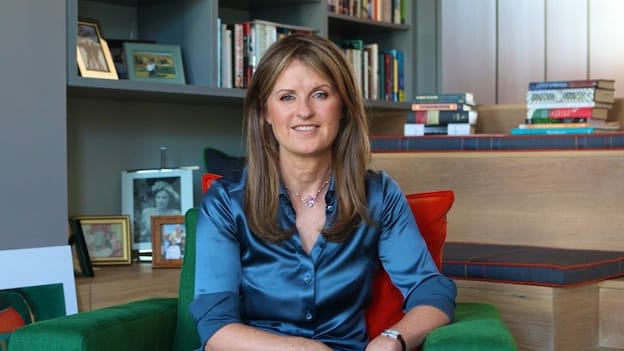"To become a great leader, discover your true nature": Deborah Rowland

“All movement (not, busy action) starts from a place of stillness. Unless leaders can create the space to witness and understand their routines, noticing what their own minds and that of the collective system are up to, then they will repeat the current routines. They will not be able to consciously choose a new path.”
Deborah Rowland is a leading-light thinker, speaker, writer, coach, and practitioner in the field of leading large complex change. Rowland is the co-author of Sustaining Change: Leadership That Works, and Still Moving: How to Lead Mindful Change. She has personally led change in major global organizations including Shell, Gucci Group, BBC Worldwide, and PepsiCo.
Rowland holds a double first in archaeology and anthropology from Cambridge University, and, alongside her change consulting work around the world to CEO’s and their teams from across all industries, she is also a member of the Archbishop’s Review Group into leadership development in the Church of England.
There’s been a great deal of literature that has been written on leadership. But we still suffer from failures in leadership, or rather from misdirected leadership. In your experience, what do you think are the biggest gaps in understanding leadership – in thought and practice?
Leadership has been studied and written about for millennia. And yes, yet we still suffer from a lack of it, across many institutions and sectors.
Leadership is not an intellectual act – it’s a deeply psychological and emotional one. To become a great leader, you need to go on an inward journey, to discover your true nature, your ‘self’ — some would say, to even discover that there is no ‘self’ — just pure consciousness, awareness.
Both my practical experience and now nearly two decades of empirical research in the field of leading change has shown that successful leaders are able to tune into and regulate their inner emotional and mental states, so that they are free of their own needs, desires and projections, and can then fully tune into and move the system around them. If leaders operate on autopilot, caught up in their own unconscious routines, then they will be blind to what needs to change in the wider system. Not many leaders are prepared to look inside themselves, into their own ‘shadows’, and know what might be being disowned and denied. It’s a courageous act. Yet the best, most selfless leaders, can do this and once they do, they can then act with greater creativity and intentionality.
What has your own extensive experience and rigorous research into change and leadership taught you and how are you bringing about change?
Leadership starts with the ‘self’. How you are and what you do as a leader has a significant systemic impact. It’s the biggest lever to successful change and my research has shown that leadership accounts for over half the reasons why big changes either succeed or fail — that’s a big swing factor. Yet, too often change efforts focus on the what of the change and its outcomes such as launching a new business model, or changing a culture. Very rarely do leaders attend to the how of the change – how the restructuring and how the culture change needs to be led and implemented. You do have choices in the how, and they are fateful – they determine where you end up. Increasingly, in today’s uncertain and dynamic world, I am working with what I call an ‘emergent’ approach to change. This approach assumes there can be no fixed outcomes but rather one sets a ‘loose intention’ for the change, and then you move in a step-by-step fashion, doing transforming experiments in pockets of the organization, and then seeing where to go next – learning and adjusting as you go.
Your core premise is that most conventional change is led through action, not movement. What is the context in which both of these operate and why should movement have precedence over action?
I define action as the “unconscious repetition of past routines” and movement as the “genuine transformation to a different place”. Too much change, conventionally, is led through “busy action”, launching lots of programs and initiatives – doing change to an organization. The problem with this approach is that it fails to change the place from which the system operates – the basic underlying mindsets and routines stay the same. Movement, on the other hand, is about going to the source of how and why a system currently produces its results, and making change interventions there, doing change with the organization, building new capabilities and sensibilities.
In my career, I have seen way too much change in busy action – an organization seeking to become more agile through a change process that is heavily predetermined and risk managed, a company seeking to get closer to its customers through a change process commanded from the center, a government organization seeking to become less formal and bureaucratic by launching its change through a set of heavily governed policy papers. In all these examples, how the change was being approached was antithetical to the very outcomes it was seeking to achieve. So, we stay in action, and not movement, because we fail to turn inward and look into the source of how and why we currently produce our results. We have significant blind spots in our perception.
In your book, Sustaining Change: Leadership that works, you have a framework for leading complex change. Tell us more about it.
Sustaining Change: Leadership that works sets out the “external practices” necessary for successful change leadership, what is it that great change leaders do that makes the difference between success and failure in large complex change. My research found there are four key behaviors necessary for success, and all four of these, in combination, enable an individual as a leader to bring about change in their organizations without you having to shoulder all the effort — the system around will start to change in and of its own accord. And what’s more, it leads to change that lasts, hence the title Sustaining Change. The four key behaviors are: Attractor leadership: a pull towards purpose, leaders who can create a shared intention, atmosphere and meaning behind the change; Edge & Tension leadership: truth is a turn on, leaders who are able to name (difficult) reality and skillfully challenge assumptions and ways of working; Container leadership: felt safety strengthens, leaders who are able to be non-anxious in the turbulence of change and productively channel the emotional energy of others; Transforming Space leadership: we only have the now, leaders who are able to create change in the here-and-now moment, walking, and not talking, their way into a new future.
You mentioned in your book Still Moving that leadership is not just about inspiring or engaging people. It is also about the inner state that needs to change too. Can you tell us more about it and why this inner change is required?
The quality of how we interact with the outside world all begins with the quality of our inner state. If we are feeling a little grumpy, rattled, anxious, overly critical, ashamed, and, we are not aware that we are having these thoughts and feelings (as we all do from time to time!), then we become those thoughts and feelings. The amygdala in our brain – our biologically inherited ‘threat detectors’ – will be inflamed and we will not act from our ‘best and most conscious self’, we might be a little defensive, brittle, overly protective of self/others, and unable to approach difficulty with wisdom and ease. Conversely, when we are in command of our inner state, we are able to observe and regulate our minds, not have our minds unknowingly regulate us, then we approach others from a deeply inspiring, calm, and available space – free of any impulsive projections. When we are in this state, as a leader, people will feel more free, secure and resourceful around us, as our emotions are contagious!
How important is it for leaders to cultivate self-awareness and both their inner and outer skills?
It’s vital. When leaders can cultivate both these inner and outer skills, it increases your chances of success in large complex change by 52 percent. That’s the stats. What does it mean? It means that change in our workplace and our world will become more effortless, less wasteful of time and energy, better for the wellbeing of self and others, and ultimately more responsible for society and the generations who will follow us. I believe that’s a cause worth striving for. And it is why I’m still doing it after three decades!
Why does mindfulness matter in a leader’s ability to lead big change?
It all starts in awareness, in becoming and intentionally staying present, non-judgmentally, to what is in front of you. When we are in judgment, we are attached to how things are, not what they might become, we stop exploring. That’s not helpful in change. Mindfulness activates the attentional circuits in the brain, overriding our default neural networks. So, when we become more mindful we notice more things — one unhappy customer that might be part of a trend, one team in our organization experimenting with new ways of working that are counter-cultural yet useful — and you can’t change what you don’t notice. Mindfulness also leads to what I call curious and intentional responding, our capacity to ‘hit the pause button’ and not immediately react to experience with our default routine but creatively respond to experience having considered what the more resourceful response in that moment might be. For example, it enables leaders not to react to ‘resistance’ to change with judgement and a desire to sell the change case even harder but to instead stop, listen, understand the resistance with greater empathy. It enables leaders not to get angry and resistant themselves when a member of their team has a different idea for how to implement the change, or get frustrated when the external regulator puts in seeming obstacles to a new business model, but instead to approach these difficulties with an open mind, seeing them as chances to rethink our own views and find a better way.
While we cannot always choose what happens to us in life, we do have the power and the freedom to choose our response.
Today, organizations focus more on leadership development – right from the start, whether it is hi-potentials or executive development. How can mindfulness be integrated into such programs?
It depends a lot on the prevailing culture of an organization. If it is a scientific, rationally driven culture, then I’d introduce mindfulness theory and practice through its own scientific basis. If it is a mission-led ethically driven culture then I’d major on the deep values and attitudes underpinning mindfulness, such as compassion, kindness and deep respect for ‘what is’. If the organization is a highly pragmatic and creative one, then I might not even mention the word, “mindfulness”, and instead introduce mindful experiences into the programs such as periodic reflective silences, inviting leaders to ‘speak from the “I”’ and not the “we/they” – and seeing how that helps the connection, quality of dialogue, and learning in the room.
Essentially, mindfulness is ‘caught not taught’, so the entire design and delivery of the leadership development experience needs to model mindful attitudes and practice. Too much leadership development stays in the cognitive, abstract and out-of this-room space (e.g. lectures and models, use of external case studies) rather than the emotional, concrete, lived here-and-now space (e.g. using the group dynamics of the participants in the room as the ‘living laboratory’ for leadership). And we know from neuroscience that most lasting learning and change happens as a result of novel experiences, not taught theory. Of course, this also means that the faculty for the leadership development needs to be carefully selected and cultivated, as a mindful and self-aware ‘holding team’ for the learning experience.
What are systemic capacities? Can you shed some more light on what these capabilities are?
My research found that while the two mindfulness capacities of staying present and curious and intentional responding were the baseline skills for successful change leadership, they were not the differentiating ones. What strongly differentiated successful from less successful change leaders where two systemic capacities, tuning into the system and acknowledging the whole. If leaders wish to create genuine movement in their change, not just generate busy action, then as I’ve said above, they need to be able to uncover the deep source of how and why their organization currently behaves as it does. This requires tuning into the system, looking beneath the surface of visible events and routines, and cultivating a deep quality of perception into the causal field beneath these events and routines. If the change is not going fast enough, rather than getting frustrated and pushing harder, can a leader examine the impact of time on current events – maybe there has been a past upset in the system, like an unacknowledged judgement of failure, that is now causing fear and low risk taking? If the top team of the organization seems to be unable to get aligned on a joint vision, rather than bringing in consultants to do personality testing, maybe the top team are systemically picking up the anxieties of the wider system – even a fractured society at large – so perhaps the intervention is to use this perceptive diagnosis as a clue into what needs healing in the wider field, rather than resorting to more event-level team building?
If leaders wish to create genuine movement in their change, not just generate busy action, then they need to be able to uncover the deep source of how and why their organization currently behaves as it does
Such ‘tuning into the system’ capacity was the number one differentiating inner quality of a successful change leader. Yet it goes against the grain of our natural ego-led tendency to personalize all of the experiences. It was accompanied by the final inner skill, Acknowledging the Whole. This is the deep capacity to give all of experience a respectful place and purpose, and in particular, difficulty. Great change leaders see disturbance as developmental, not dysfunctional. It kind of acts as a ‘target marker’ that they head towards, not something awkward to criticize and exclude. If difficulty is denied (like a team avoiding feeling into the emotional pain of exiting staff in a change) then it will only get bigger (people staying will feel the guilt and shame of their departed colleagues). Systems only get stronger, not weaker, when difficulty is seen and not denied. So, encourage your team to talk about what feels like the unsafe and risky subjects, when meetings seem to ‘go off the rails’ don’t judge the people or blame yourself but ask, “what was that difficulty serving and teaching us?”
While this acknowledging the whole skill was very rare in the change leaders we studied, it was clearly present in the successful leaders at the senior levels of an organization stewarding their organizations through complex and difficult change.
What do you think are the leadership mantras for increased productivity, employee engagement, and responsible societal impact?
Well, I guess this is the so-called “triple bottom line” of profit, people and purpose. Great leaders attend to all three – passionately, and not just with lip service.









